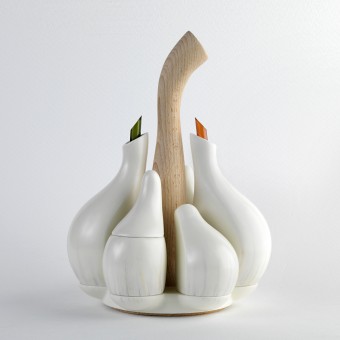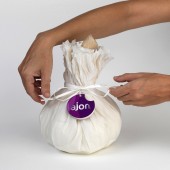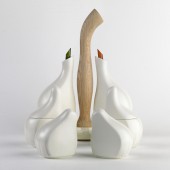
| THE AWARD |
| CATEGORIES |
| REGISTRATION |
| SUBMIT YOUR WORK |
| ENTRY INSTRUCTIONS |
| TERMS & CONDITIONS |
| PUBLICATIONS |
| DATES & FEES |
| METHODOLOGY |
| CONTACT |
| WINNERS |
| PRESS ROOM |
| GET INVOLVED |
| DESIGN PRIZE |
| DESIGN STORE |
| THE AWARD | JURY | CATEGORIES | REGISTRATION | PRESS | WINNERS | PUBLICATIONS | ENTRY INSTRUCTIONS |
Ajorí Cruet. Condiment Container by Carlos Jimenez and Pilar Balsalobre |
Home > Winners > Design #31751 >Interview |
 |
|
FS: What is the main principle, idea and inspiration behind your design?
Ca: Ajorí is the first piece of a collection named “NATURA IMITATIS”. The source of inspiration came from the patient study and interpretation of different natural elements that eventually started suggesting a number of design concepts. We managed to fit the Ajorí into a biomimetic design, inspired by the natural shape of the garlic.
FS: What has been your main focus in designing this work? Especially what did you want to achieve?
Ca: Our main objective is to integrate an esthetic and functional background on every aspect that integrates the design. We pretend to make the shape and function clear, simple, universal and this among a high esthetic aspect. Finally, we associate a Spanish character to our design line of functional products for the table and kitchen. On the other hand, as a design studio, we want to summarize in one design piece, our philosophy "NATURA IMITATIS": - The pieces of each design, and its packaging are both environmentally sustainable and are made entirely from natural, biodegradable and recyclable materials. - In its manufacturing process, we minimized energy use and pollutant emissions. - We used a mix of modern technologies, with the expert hands of master craftsmen which used ancient techniques, many of these ancestral. - The design piece, works well in a metaphorical level, as a bottle thrown into the ocean with a message inside: the future of humanity lies in the imitation of nature.
FS: What are your future plans for this award winning design?
Ca: Our next step with this design is a global commercialization, but mainly we want it to serve as a first example of the line of designs collection "NATURA IMITATIS", inspired by nature.
FS: How long did it take you to design this particular concept?
Ca: Once we cleared the concept, what took most of the time was being able to put all the pieces and materials together while maintaining the functionality and esthetic impact of the object. Also, being able to coordinate each expert in his area to go through the production process was tough. We´ve invested approximately 8 month to go through the main objectives.
FS: Why did you design this particular concept? Was this design commissioned or did you decide to pursuit an inspiration?
Ca: The Ajorí was a piece that we had designed in order to participate in a Spanish competition of design applied to the craft with free theme, where the objects should reflect the Spanish essence. We wanted to create a functional object for the table and kitchen, inspired by a natural element and with a strong esthetic. Ajorí was submitted to the 25th contest "Design applied to the crafts of Castilla la Mancha" (Spain), where finally won the first prize.
FS: Is your design being produced or used by another company, or do you plan to sell or lease the production rights or do you intent to produce your work yourself?
Ca: Carlos Jiménez and Pilar Balsalobre are the founder of the design studio photoAlquimia. The philosophy of the studio is to be able to supervise de development of the design and production process for each piece, Also it is important for us to maintain close relation with the possible buyer, our craftsmen, our studio and philosophy.
FS: What made you design this particular type of work?
Ca: The main motivation we have in our work is the possibility to associate a philosophy of life, love and beauty inside a functional object, plus the ability that this one can have to reach many people and world cultures.
FS: Where there any other designs and/or designers that helped the influence the design of your work?
Ca: The most important influence that we can have as studio when we carry out our designs has been the work of the Spanish architect and artist Antoni Gaudi, all inspired by nature. "Beauty is the splendor of truth and as the art is beauty, without truth there is no art. "A. Gaudí.
FS: Who is the target customer for his design?
Ca: We direct our designs towards people around the world, especially people who are sensitive to beauty, nature, and art lovers, which are very demanding when they buy a certain design. These people are very aware of environmental sustainability and in other ways to understand the use of an object. They do not buy objects, but ways of understanding and living life.
FS: What sets this design apart from other similar or resembling concepts?
Ca: With its garlic shape, Ajorí integrates in a functional level, a complete set of culinary seasoning, maintaining a unique and recognizable image, very different of the large number of designs of cruets and Salt & Pepper currently existing on the market.
FS: How did you come up with the name for this design? What does it mean?
Ca: We devote a lot of time and effort in the search and creation of the name of our designs, as we feel this is an important part of the object we are designing. We search words that, with their sound or meaning, can summarize and provide features to each design about the inspiration source or about its specific functionality. Ajorí is the name we have given to this cruet. Phonetically, it is a short name, simple, with great musicality and easy to remember. The root of the word Ajorí comes from the word garlic, "ajo" in Spanish. The name can evoke a mixing sauce of garlic and oil, used for dressing homemade dishes. The typography used in the name of the brand is conceived with rounded lines following the shapes of the garlic cloves. With this typography we play to associate the source of inspiration for the piece, the garlic, with its functionality cruet. So, the last two letters form a liquid dispenser, where "r" represents the dispenser, and the accent on the "í" assembles the liquid.
FS: Which design tools did you use when you were working on this project?
Ca: In the first project phase, we always use traditional tools such as a pencil, paper, wire and modeling clay. When the shape and size of the design is more or less defined, we use diverse 3D software for visualization and exploded view of the object, as well as for the production of some parts such as the originals and the tooling to make the molds for the porcelain pieces.
FS: What is the most unique aspect of your design?
Ca: The universal clarity of form, associated with a functional logic. The harmony existing between its esthetics and the many features it provides.
FS: Who did you collaborate with for this design? Did you work with people with technical / specialized skills?
Ca: In the first phase of giving shape to the idea, the architect Jorge O. Viñas collaborated on this project in order to resolve technical problems and 3D modeling. For prototyping, we work with Neil Callaghan, master carpenter, and Manuel Sanchez, ceramist.
FS: What is the role of technology in this particular design?
Ca: From the inspiration phase of the design, to the realization of prototypes, we have worked with traditional tools, except 3D software as a complement to the sculptural modeling of the first prototypes. For the production phase, we have used 3D scanning and CNC for the carving of the originals and tooling used for the realization of casting molds for porcelain. For the realization of the base, we used high pressure techniques for porcelain.
FS: Is your design influenced by data or analytical research in any way? What kind of research did you conduct for making this design?
Ca: For our designs, we seek inspiration from archetypal symbols and concepts of our unconscious, simply recognizable on a universal level. We are guided much by our intuition, although we often work throughout the design process, with a very heterogeneous group of people who provide different views and suggestions on the idea or design.
FS: What are some of the challenges you faced during the design/realization of your concept?
Ca: At the beginning everything seemed easy, but soon we encountered many difficulties that we had to solve. The most important challenge was to integrate in one piece, three different materials that compose this design in addition of modeling different parts of the design, making sure that as a whole it resulted in a simple recognizable form. The two anti-drip cannulas of the cruet, are made of borosilicate glass and are hand carved, as in jewelry. For the production process of the porcelain, it took much effort to find a porcelain factory that accepts this complex project.
FS: How did you decide to submit your design to an international design competition?
Ca: We decided to submit this design for this competition, encouraged by the good acceptance and by the numerous publications on websites and blogs design that was having the Ajorí internationally, while several publishers in different countries had proposed us to publish Ajorí in several books of international design.
FS: What did you learn or how did you improve yourself during the designing of this work?
Ca: With every project that we design and see all the way through, we learn many new things. With this design in particular, the most important lesson we have learned throughout its design process, has been the high level of difficulty that arises when we look for maximum simplicity. This seems to always happen when we are confronted at nature-inspired designs.
FS: Any other things you would like to cover that have not been covered in these questions?
Ca: Thank you for the opportunity to share our work and express some of our ideas.
FS: Thank you for providing us with this opportunity to interview you.
A' Design Award and Competitions grants rights to press members and bloggers to use parts of this interview. This interview is provided as it is; DesignPRWire and A' Design Award and Competitions cannot be held responsible for the answers given by participating designers.
| SOCIAL |
| + Add to Likes / Favorites | Send to My Email | Comment | View Press-Release | Translations |




